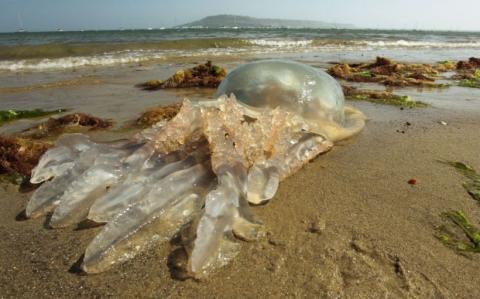
New Giant OZ Jellyfish
Australian scientists have been left stumped by the discovery of what appears to be a new species of lion’s-mane jellyfish, that washed ashore on a beach in Southern Tasmania. The jellyfish, which appears to be nothing more than a giant blob, has no tentacles. Scientists are still trying to figure out whether this is the norm, or the exception for the species.
The marine scientist in charge of the discovery, Lisa-Ann Gershwin, told the Australian Broadcasting Corporation that in spite of it having been spotted before, the specimen has still not been officially classified, and is still considered a new species. The jellyfish which washed ashore is a particularly big specimen, stretching to about 5 feet long.
One of three species of a variety of jellyfish known colloquially as “snotties”, the lion’s-mane jellyfish is named for its likeness to the regal fur of the African beasts. Its sting is said to be dangerous, but rarely deadly, and can potentially induce the Irukandji syndrome, which results in nausea, vomiting, and sometimes in extreme cases, even a stroke. Most of the species don’t grow to more than the size of a fingernail, but this particular specimen was a “whopper”, as put by Gershwin.
She also hypothesized about its missing tentacles, saying that it was possible for the jellyfish to have shed its tentacles as a defense mechanism, as with some species of bioluminescent jellyfish that do so to distract their prey. However, there was no evidence that this was the case so far.
The species was photographed earlier in the 1980s, but a real specimen was never captured until 2013, when the marine scientist John Keesing found one in Shark Bay. In recent times, scientists have expressed interest in the large number of such species that have been spotted off the coast of Tasmania this year.
“We don’t actually know what’s going on that’s led, not only to this species, but many, many types of jellyfish blooming in massive numbers. Jellyfish do bloom as a normal part of their life cycle, but not usually this many.” Gershwin commented.
With the discovery of this new species, Gershwin along with other members of the marine wildlife conservation community hope that their numbers will increase in the future, as they are develop particularly well in damaged ecosystems, from which sharks and other predators have been removed.
